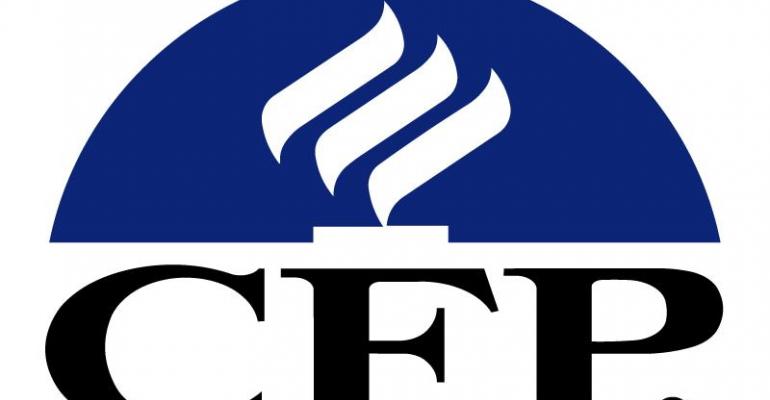For advisors pondering whether the certified financial planner designation is worth the time and expense to obtain, a new report by Aite Group in Boston suggests the answer is yes.
Aite found that solo practitioners with the CFP certification produced 40 to 100 percent more revenue than solo advisors without the CFP. Seventeen percent of solo advisors with CFPs and less than 10 years of experience earned more than $215,000, while just 8 percent who lacked CFPs and had less than 10 years of experience earned that amount, Aite said.
Among team practices, those led by a member with a CFP are 30 percent more productive than teams that lack someone with the designation, Aite added.
The research firm said high-net-worth clients are seeking multi-disciplinary knowledge and greater client focus from advisors, and those with CFPs are seen as fitting that bill. Such relationships generate more fee-based income over time because they last longer, Aite said. And they produce greater share-of-wallet; practices with CFP members manage 45 percent of client assets for fees, compared to 30 percent for others without the designation.
“CFPs are indeed very valuable, particularly for going after that high-net-worth investor, because they can bring together a lot of disciplines through their financial planning approach,” Aite Senior Analyst Sophie Schmitt says. Seventy percent of team practices that were surveyed had at least one CFP on board, she adds.
The report was commissioned by the CFP Board of Standards. It surveyed 515 advisors and executives from eight broker/dealers and a financial services firm. Schmitt and Tom Crowder, CFP’s managing director of marketing and business development, said it was the first attempt to quantify the benefits to advisors who hold the mark.
“Overall, I think it was confirmation of what we’ve been hearing for years,” Crowder says. “It leads to your ability to deliver better quality advice, to better serve your customers. Through that, you’re more productive.”
“There’s anecdotal information about CFPs versus non-CFPs floating around within companies,” Schmitt says. “But I think no one had really sat down to say, one, ‘Is this a good way to measure production differences,’ and, two, ‘What are the things that are important that separate out the CFPs from the non-CFPs?’”
More than 66,000 advisors hold the mark, or about 20 percent of total practicing advisors in the country. Obtaining the designation is no small undertaking. It requires the completion of six educational components across multiple disciplines, such as investments, estate planning, income tax, and retirement planning.
It can take up to 18 months. Advisors with certain backgrounds may opt out of some courses, but everyone who wants the CFP must take a capstone course that the program recently instituted. And there’s also a 10-hour exam, given over two days. The cost of the wh ole undertaking is several thousand dollars at a minimum, plus the time value of money.
Indeed, some advisors have written off the mark as having any value for their practice. Aite’s report found that the longer an advisor was in practice, the less likely they were interested in pursuing the mark. (Half of advisors with more than 25 years in the field said they had no interest.)
Some brokerages also are less interested in the designation because it conflicts with their business model. B/Ds are required to provide investment suggestions that are suitable for an investor’s needs, but holders of CFP marks have a higher fiduciary standard that requires the client’s needs to always come before the advisor’s.
But the possibility that a fiduciary standard may be applied in coming years to the B/D world has some firms moving in that direction already, Aite observes. FINRA tightened up its suitability definition this summer; Schmitt says a fiduciary standard on the broker side is inevitable.
One enduring misunderstanding among investors, Schmitt says: many assume, incorrectly, that their advisor has a CFP, although HNW investors are more sophisticated and tend to not fall into that mistake.
The satisfaction that investors derive from working with CFP holders gives those advisors an edge, she adds; 87 percent said they were “satisfied” or “very satisfied” with their relationship, compared to 72 percent of investors who work with advisors who lack the mark.
There’s a view among some financial executives that people who obtain the CFP are younger and “naturally more motivated,” and it’s this quality that drives their success more than holding the designation, Schmitt says. Aite’s research shows, however, that the success continues among CFP advisors with older practices; 44 percent of those in the business more than 13 years after obtaining the mark are earning $141,000 to $215,000.
“Advisors who are surviving past 15, 20 years, these advisors have found successful business models. They’re still in the industry,” Schmitt says. “They are more holistic in their approach, they’re uncovering more of their clients’ needs, they’re more effective at cross-selling potentially insurance solutions, annuities. They’re not doing as much commission business.”





